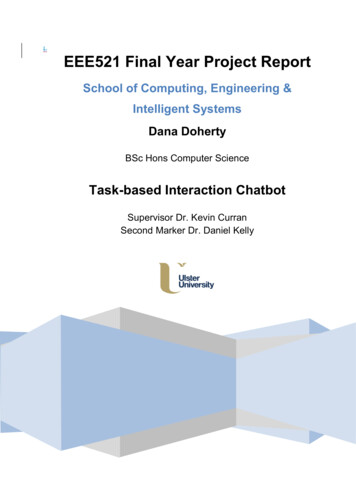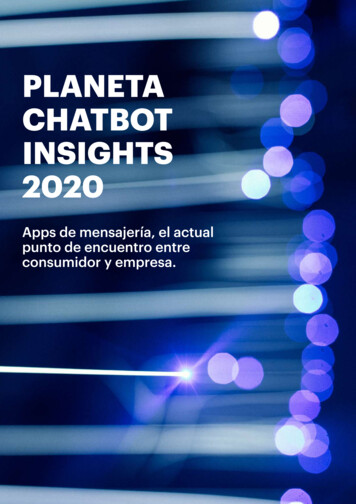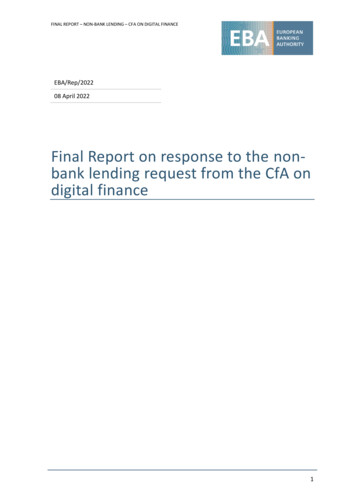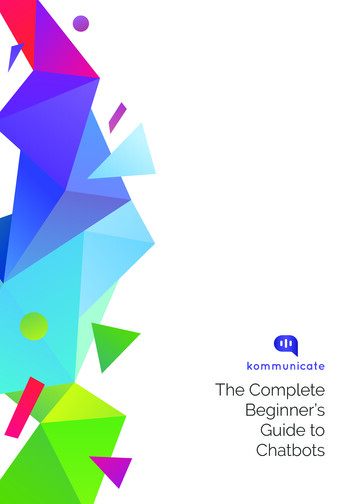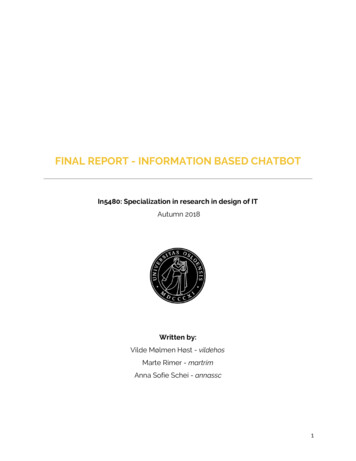
Transcription
FINAL REPORT - INFORMATION BASED CHATBOTIn5480: Specialization in research in design of ITAutumn 2018Written by:Vilde Mølmen Høst - vildehosMarte Rimer - martrimAnna Sofie Schei - annassc1
Table of content1 . Introduction32. Questions: Using a chatbot in a school context33. Background44. Design process and methods55. Prototype65.2 Persona76. Early testing and findings76.1 Testing the prototype86.2 Results from the first testing86.3 Re-design of the prototype87. Evaluating the chatbot8. Discussion and conclusion9112
1.IntroductionOur names are Marte Rimer, Anna Sofie Schei and Vilde Høst, we are all first-year masterstudents on Design, use and interaction. We know each other from the interaction designbachelor here at ‘Institute For Informatics’ hereby referred to as IFI. We all think AI as a fieldis very interesting and are looking forward to having a lot of professional discussions aboutthe topic through our project work.1.2DescriptionIn our project we explore how a chatbot can give information to students aboutschool-related information. In the first iteration of the project we created a chatbot for givingstudents information about where to get coffee etc. at IFI. One of our hypothesis was thatinformation given by chatbots would be useful for new students at IFI, giving theminformation about things that we consider to be important when you’re a first year students.In the second iteration we wanted to explore the use of chatbots through theory and usedthis in combination with testing to learn more about how a chatbot for this context shouldbe. In the final iteration, iteration three, we improved and changed the chatbot based on theresults from the last iteration and made a plan for evaluate the chatbot. The plan was thenexecuted with five participants. In our conclusion we discuss the results from the evaluationin the light of our research question.2.Questions: Using a chatbot in a school contextWe wanted to investigate users' trust in an AI system such as a chatbot. We thereforedesigned a research questions we wanted to look further into.“How will helpfulness affect trust in chatbot technology for students at IFi when it comes toschool-related information?”A chatbot needs a purpose, and if we consider that if this purpose is to be helpful, it alsoneeds to gain trust from the users. There is no need to ask a chatbot for help if you don’ttrust the information it gives you. With this in mind we consider the first question to be a bittoo ambiguous and large for us to investigate in this course. We have therefore used thisquestion as a guideline for what we can actually manage to explore in this course and whatwe can find on the existing literature in this field. Trust is an important factor for reliance onand implementation of technology (Lee & See, 2004). In relationships trust means beingreliable, having confidence in the other person both physically and emotionally (Lewicki &Bunker, 1995). So one can say that trust will also play a role in the interplay between humanand machine. The problem with systems taking control is that it’s often hard for people torely upon it appropriately. Because people respond to technology socially, trust influencesdependence in it. So trust will inevitably guide reliance when we are faced with complexand unanticipated situations. When we use systems to navigate and make decisions about3
our health, finances, relationships, and future — they must be trustworthy. Inhuman-technology interaction trust is an example of the important influence of affect andemotions. Emotional feedback in technology is not only important for acceptance, but canalso make a fundamental improvement regarding safety and performance (Lee & See,2004).To make the project more feasible we wanted to explore the following questions:1. How useful is information given by a chatbot compared to a human counsellor?2. Does students find information given by a chatbot trustworthy?By exploring these questions we hoped to get indicators on how students experienceinteracting with a chatbot contra interacting with a human, and address if the studentsprefer one communication format over the other. This was done via selected methods in thedesign process, see chapter 4. Due to time constraints we later in the project had to focusour efforts more on the second question.3.BackgroundChatbots has emerged as a hot topic in the latest years, and it is used by numerouscompanies in various areas - help desk tools, automatic telephone answering systems,e-commerce and so on. Even though the technology has been around since the 60’s (Atwell& Shawar, 2007). Why are we suddenly so interested in this technology now? This can likelybe explained by the recent year's advancements in messaging applications and AItechnology (Brandtzaeg & Følstad, 2017).In the article Chatbots: Are they really useful? Atwell and Shawar provide real-life examplesof different chatbots in different contexts. One of the examples is Sophia, a robot that wasdeveloped to assist in mathematics at Harvard by answering students questions. Thisturned out to be applicable in many other contexts. Living in Norway you have probablynoticed “Kommune Kari”. A chatbot that many of the municipality have available on theirweb-pages. Kari is there to answer “easy” questions like “when will the garbage truckcome?” and “where can I find available jobs?”. Kari’s goal and the job is to provideinformation so that you as a user don’t have to navigate the “massive information flow”(Schibevaag, 2017). This way of using a chatbot is a part of the Question Answering (QA) fieldwhich is a combination between AI and information retrieval (Molla & Vicedo, 2007). QA canbe defined as:“. the task whereby an automated machine (such as a computer) answers arbitrary questionsformulated in natural language. QA systems are especially useful in situations in which a userneeds to know a very specific piece of information and does not have the time—or just does notwant—to read all the available documentation related to the search topic in order to solve theproblem at hand”. (Molla & Vicedo, 2007).4
Sophia and Kari are examples of chatbots that operate in “very specific” domains. Thismeans that if you were to ask Kari about math and Sophia about when the garbage truckcomes none of them would know the answer - because the question is outside of theirdomain. Chatbots have what is called a natural language user interface and thereforecommunicate with users via natural language ㅡ how a human would talk on a regular basis(Brandtzaeg & Følstad, 2017). Therefore they use what is called natural language processing(NLP) where the chatbot uses computational techniques to analyze text, where the goal isto produce a human-like answer based on a linguistic analysis (Hirschberg & Manning, 2015).For a chatbot to be especially useful to a certain domain some criteria have to be met.Minock (2005) proposes the following criteria for a domain to be successful in answeringdomain-specific questions: a domain should be circumscribed, complex and practical. Thisis summarized in the table below.CriteriaDescriptionCircumscribedClearly defined knowledge sources andcomprehensive resources available (adatabase etc.)ComplexIf you could develop a simple FAQ then itwould not be useful with a QA system.There has to be some level of complexity inthe domain while still being able to meetthe circumscribed criteria.PracticalShould be of use to a large group of peoplein the domain and take into account: howthe users will formulate questions, what iscommonly asked and how detailed theanswers should be.When designing an intelligent system that provides decision support one must consider thehuman as something outside the system, but also as an integrated system component thatin the end, will ultimately determine the success or the failure of the system itself(Cumming, 2004).4.Design process and methodsFor the project, we wanted to have a simplified user-centred approach (hereby referred toas UCD). UCD is an iterative design process in which designers focus on the users and theirneeds in each phase of the design process (Interaction design foundation, unknown). UCD5
calls for involving users throughout the design process via a variety of research and designtechniques so as to create highly usable and accessible products for them. The reason whywe wanted to have a UCD design approach is to use the chatbot to explore how the userscan, wish and needs to use the chatbot to achieve their goals.Our goal was to facilitate user involvement through interviews and to learn about theircontext. The interviews was small where we tried to understand people’s opinion about thesubject. They were not only a conversation between the us and the participant but we alsoasked participants to execute some tasks interacting with a chatbot. Afterwards we askedthem questions about the experience.5.PrototypeWe made a chatbot that we used as a prototype toinvestigate the research questions. The chatbotwas originally made for appendix 1. But we wantedto further use this in our project. During the designprocess we improved and tested the prototype.We tried to make it as helpful as we could managewithin the time frames of the project by iteratingmultiple times.Fig 1: first draft of our prototype5.1How the chatbot meets Minock’s three criteria:Circumscribed - the information given to first year students are usually dispersed ondifferents sites and information channels. The information are usually given in a way wherethe students have to perform workarounds to retrieve the information. A lot of information isnot written and usually learned and retrieved from other older students. This somewhatcontradicts the goal of the system being fully circumscribed. Most of the information isfound at the UiO webpage which we see as a “circumscribed source “ but we also want toinclude the more verbal information.Complex - the UiO webpage has many versions of FAQ s but is in our experiencesometimes to general. Because of the dispersed information and the different types ofinformation a fully function chatbot in a school context should have, this could not berealised by a simple FAQ. Making a chatbot that is more advanced than a FAQ is not feasiblein our project. But is rather a reason for using a chatbot in a school context, such as IFI.6
Practical - Our chatbot is designed to meet the needs of a large group of students at IFI.We believe that it is practical in the sense that it detects short questions like: “I am hungry”and “Food” or “Where is Epsilon?” and “I can’t find my classroom”. Which in turn can reducethe time it takes for the students to locate this information. This can also be used as a way togather data on the information that students are interested in.5.2PersonaIn the making of the prototype we also formed a persona for the chatbot to make thechatbot consistent in its language. This worked as a guideline in the design of the chatbotand was very helpful since it gave us a common understanding of the chatbotscharacteristics. We focused on building the chatbot as an engaging partner with a “happytone” and a sense of humor, including GIFs to make the experience more fun and intriguing.6.Early testing and findingsIn the beginning of our project we wanted to test the first version of our chatbot (fromappendix 1) on first year students. This was late in the fall and most of the first year studentswere familiar with a lot of the answers our chatbot could provide. We therefore developed ascenario to help the participants imagine the context of use (see figure 2). We wanted to testthis early version of the prototype to get input on what the chatbot could and could notanswer in the future. After the test was completed we had a short interview with theparticipants. The main purpose for this test was to see how the participants interacted withthe prototype and find out if a chatbot could be suitable to find the information theyneeded. Before the testing we also carried out a pilot test to find immediate flaws in theplan.Fig 2: Scenario for use case7
6.1Results from the first testingThe first participant enjoyed talking to the bot, but stressed the fact thatyou had to “talk like “a dummy” for it to understand what you wereasking. The participant pointed out that this really would have come inhandy in his first weeks at the university, as he didn’t always know who toask - especially if he was in a hurry. He pointed out that the prototypeneeds to get more features like tell you exam dates, or “ifi life-hacks, likeget your coffee before all of the students have their break”.The second participant was a bit frustrated that the chatbot wasn’tflexible enough (Fig.3). “I don’t like having to guess what questions to ask”. He would likedmore instructions to know how to get more out of the chatbot.The third participant had also problems with understanding what the chatbot could do.When given a hint for what the chatbot could do, the chatbot did not function properly.Here we tried to restart the system and then the chatbot displayed it s welcome message一what it could do. Afterwards it was more clear what the participant could ask it, but thechatbot did not always give the response that the participant wanted.6.3Re-design of the prototypeThis findings gave us a lot of insight in where the chatbot needed to be changed. E.g. addinga proper welcome message, defining the chatbots’ limitations and presenting this to theuser. Luger & Sellen (2016) argues that it’s important to define goals and expectations sothat your chatbot has a clear purpose. Knowing the capabilities and limitations of thesystem, before it crashes. The test showed that it was hard to ask the ‘right’ questions, wetherefore added more ‘AI ques’ to simplify the interaction. We also used the principles fordesigning conversational agents. When talking about User-centred design of AI there arethree (tentative) design principles: learning, improve and fuelled by large data sets (Følstad,2018). The principle of learning is how the system is designed for change. Setting theexpectations right, with the system's ability to perform and its ever changing nature. Theprinciple of improve is how the system should be designed with ambiguity. The system ismore than likely to make mistakes, so learning from these are an important principle toimprove the system. The principle fuelled by large data sets is how the system is reliant ongetting access to enough data.8
7.Evaluating the chatbotWe wanted to evaluate the prototype in the right context, which for the IFI chatbot was atIFI. As mentioned before, most of the new students are more or less ‘integrated’ per now wecould not test on “real potential users”. How ever we consider IFI-students as a goodsubstitute since they have been in the situation before and a group that we easily can makecontact with.We listed a set of questions and tasks, see figure 4, wich we asked the participants toanswer and preform. We also included a few control questions to investigate theparticipants experience with the chatbot and to find out if they had any suggestions forfurther improvement. The evaluation ended with a short talk about the experience, wherewe were open for any kind of feedback the evaluators could provide.Due to time and capacity during this project we decided on including five participants actingas evaluators. The number of participants is also chosen on the basis that five participantscan contribute to finding 80% of the usability flaws (Lazar et. al. 2017). The evaluation wasformed as a formative usability test where the goal is to look at metrics that are morequalitative than quantitative (Lazar et. al. 2017). In the evaluation we wanted to combinesmall semi-structured interviews with the users executing tasks because this could give usmore information about the experience beyond the metrics.9
7. 1The evaluation planSet upCandidates:Five randomly picked evaluators, the only criteria is that they havto be students from IFI.Context:In the Institute for informatics buildingWarming up-Task’sHave you talked with a chatbot before? If yes: What type ofchatbot?How do feel about getting information from a chatbot? Do youconsider the information as more or less reliable?Scenario: Imagine you are a new student. Use the chatbot and try tofigure out when your next lecture starts, which room it is in and whereis it located? Later you are feeling thirsty and are interested in a cup ofcoffee near the university.Tasks:Use the chatbot to find out:Where is the room named ‘Normarc’?Where can you buy coffee at ifi?Have a chat with the chatbotControlquestions-Did you feel like the chatbot gave you a good answer?Do you think that the answer from the chatbot wastrustworthy?Do you feel a need to ‘double check’ the answers you got fromthe chatbot?If you were to rate this chatbot from 1-6 where six is the best,what would you rate it?If low: What improvements does it need to get a six?Figure 4: Evaluation plan10
7. 2The evaluationThe evaluation was carried out with 5 participants at IFI, where each session took about 5minutes. After the first session we had to make some quick changes to the chatbot becauseit suddenly froze. We also discovered that it was casesensitive which we changed beforethe next session. In general the evaluation went good and we gained a lot of insight fromthe participants. Bellow we have summarized the main findings from the evaluation.7.3 Findings from the evaluationAll of our participants reported that they had interacted with chatbots before, but had verylittle knowledge about how they worked. They found the chatbot to be nice to interact withand enjoyed that it had a friendly and casual tone. One of the participants said that she didnot want a chatbot that felt too ‘human-like’, and that the prototype did not feel ‘human-like’at all. This became clear when the same error message appears several times during thetest.They found it hard to get the right answer but when they did they were very satisfied withthe answers. “It was a good answer when I finally got the right one.” . It was pointed out thatthe chatbot was not a smart chatbot, but that it provided the most necessary informationsparing them from precious time spent on ‘Google’.They also reported that they trusted the answers they got, and they all pointed out that itwas good that the chatbot provided a source along with the information it gave. The gifsand the pictures were also very popular among the participants, they said that this made thechatbot fun to interact with. One of the participants said that: “ It’s casual, and extra fun withGIF’s” .One of the participants also stated: “ I liked that the chatbot was casual and cute. I don’t wanta formal and boring chatbot, then I could have tried to find it on the university's web-pages.” Itwas also pointed out that it was preferably that the chatbot could provide diverseinformation, “ Usually, the information is so spread that you don’t know where to look ”.8.Discussion and conclusionWhen testing the last prototype we got findings suggesting that the participants did nothave a problem with getting information from a chatbot instead of a human. The informationthat they got was not seen as less trustworthy, this could be supported by the fact that thechatbot provided a source for the information it gave. It has been interesting to investigatehow the participants interacted with the chatbot and how they reported on it afterwards.Our findings have some indicators leading towards that a chatbot could be a goodalternative for acting as a helpful friend for freshmans at a new school. Still we have tostress the fact that the chatbot was not very intelligent and that the evaluators had to adjusttheir language to match the chatbots.11
Because of the scope of the project we did not have time to conduct as much user testingand re-design to the chatbot as we would have liked. This has an impact on the validity ofour research. Through the project we have touched on some theory when making thechatbot, but this should also have a larger focus for higher validity. Even though theparticipants trusted the information given in this project we cannot say that people trusts achatbot as much as they trust a human being. There are also biases in our project, one ofthem is that all the students that we included in the project already knew a lot of the answerthe prototype could provide. Another bias is that the information the chatbot provides couldbe seen as “casual” and are not crucial and/or vital This could have had an impact on theresults regarding trustworthiness.With that being said we also think that some of our findings could give some insights intohow a very small group of people think about using a chatbot to gain information in a schoolcontext. Some of the characteristics of our chatbot was viewed as appropriate for the givencontext, like “casualness” and links to where the information was gathered. If the IFI chatbotis to be furthered developed, this could be something to draw upon.REFERENCESCummings, M., 2004. Automation bias in intelligent time critical decision support systems, in:AIAA 1st Intelligent Systems Technical Conference. p. 6313Følstad, Asbjørn (2018), INTERACTION WITH AI – MODULE 2 - Session 1, UIO ng-with-ai---module-2---session-1---v02.pdfHung, V., Gonzalez, A., & DeMara, R. (2009, February). Towards a context-based dialogmanagement layer for expert systems. In Information, Process, and KnowledgeManagement, 2009. eKNOW'09. International Conference on (pp. 60-65). IEEE.Jung, M., Hinds, P., 2018. Robots in the Wild: A Time for More Robust Theories ofHuman-Robot Interaction. ACM Trans. Hum.-Robot Interact. 7, 2:1–2:5.Lazar, J., Feng, J. H., & Hochheiser, H. (2017). Research methods in human-computerinteraction . Morgan Kaufmann.Lee, J. D., & See, K. A. (2004). Trust in automation: Designing for appropriate reliance. Humanfactors, 46(1), 50-80.12
Lewicki, R. J., & Bunker, B. B. (1995). Trust in relationships. Administrative Science Quarterly,5(1), 583-601.Lindblom J., Andreasson R. (2016) Current Challenges for UX Evaluation of Human-RobotInteraction. In: Schlick C., Trzcieliński S. (eds) Advances in Ergonomics of Manufacturing:Managing the Enterprise of the Future. Advances in Intelligent Systems and Computing, vol490. Springer, ChamLuger, E., & Sellen, A. (2016, May). Like having a really bad PA: the gulf between userexpectation and experience of conversational agents. In Proceedings of the 2016 CHIConference on Human Factors in Computing Systems (pp. 5286-5297). ACM.Schank, R. C. (1987). What is AI, anyway?. AI Magazine, 8(4), 59.Winograd, T. (1991). Thinking machines: Can there be? Are we (Vol. 200). University ofCalifornia Press, Berkeley. (p.204-210)Schibevaag, T.A. (2017, 27. September). - Hun vil revolusjonere Kommune-Norge. NRK.Hentet fra ne-1.13706709Abu Shawar, B., & Atwell, E. (2007). Chatbots: Are they really useful? Journal for LanguageTechnology and Computational Linguistics, 22(1), 29-49. Retrieved fromhttp://www.jlcl.org/2007 Heft1/Bayan Abu-Shawar and Eric Atwell.pdfBrandtzaeg, P. B., & Følstad, A. (2017). Why people use chatbots. In I. Kompatsiaris, J.Cave, A. Satsiou, G. Carle, A. Passani, E. Kontopoulos, S. Diplaris, & D. McMillan(Eds.), Internet Science: 4th International Conference, INSCI 2017 (pp. 377-392).Cham: Springer (LIGGER UNDER RESSURSER)Molla, D. & Vicedo, J.L. (2006). Question Answering in Restricted Domains: An lus/10.1162/coli.2007.33.1.41Minock, M. (2005): Where are the “‘Killer Applications’ of Restricted Domain chberg, J. & Manning, C, D. (2015). Advances in natural language processing. Science 349,261/266.Interaction design foundation (unknown). User centered re/topics/user-centered-design13
Appendix 1: Report on conversational interaction assignmentTo make the chatbot we used the program ‘Chatfuel’, that allowed us to make a chatbot inFacebook’s messenger app. This was easy to use and we managed to actually make achatbot within a day.In the making of the chatbot, we thought about how the chatbot could be useful and easyto interact with. The chatbot we ended up making was a chatbot that new students coulduse to get simple information such as where you can get coffee, where you can find theroom you are looking for and where you can get food when you are at school.To make the interaction more enjoyable we tried to make the conversation playful and wealso included some gifs to make it more fun. To make the chatbot easier to use we includeda lot of trigger words so that you didn’t have to know the specific words to trigger the rightanswers. We also included a message that said “I’m sorry I’m not that smart yet, try google”with a link to google, for whenever the chatbot could not answer. While we built the chatbotwe also tested it a lot, to make sure that it gave the answers it was supposed to do.Appendix 2: Report on machine learning assignmentFor this task, the purpose was a bit unclear. We could see that it changed when tweakingthe values on Epoch. As one epoch consists of one full training cycle on the training set, wepredicted that it would get smarter as we changed the number to 15. But the validityaccuracy did not get higher than 0,03 and the conversation was still very abstract. Difficultto decipher which of the characters that were talking.Each of the layers is mathematical layers, given the input we get the output. In our chatbot,we only had two layers, but if you add more layers you will get more a more complexnetwork which then could create more patterns. The drawback is that it would take muchlonger time.14
Appendix 3: Report on problems with AI taskTo this assignment we used this video:https://www.youtube.com/watch?v sgJLpuprQp8Fig X S creenshot from ‘ SMARTHUS Det enkle er ofte det beste REMA 1000’ v ideo on youtube.Which is a constructed video made by ‘Rema 1000’. The video shows a man living ina smart house where he interacts with various technologies using his voice. Thevideo starts smoothly, describing a simple life living in a smart home. The problemsarise when he has to go to the dentist, where he gets anesthesia which makes itdifficult for him to say certain words and letters. This complicates things in a smarthouse where everything is controlled by his voice.Even though the story portrayed is a fictitious one we consider it to be a possiblescenario in real life. Especially with the voice recognition technology we have now.By proper testing this problem would probably have been detected early. Thesystem should also have other interaction possibilities like text input when speech isnot possible一like in the video. You could have a functionality when training thespeech-recognition software where you should can talk unclearly so the softwareknows this. But we also think there also should be a possibility to “override” the maininteraction, like with the use of text. Because it can be very difficult to predict everypossible outcome.15
Appendix 4: Report on human-machine partnership taskWe think that an intelligent agent that will take care of recruitment and hiring ofnew employees should have the following functionality:- Screening of applications : like CV to look for experience, education etc. thatare of relevance to the company. This can reduce the time it takes to gothrough applications, but the relevant “keywords” must be defined by thecompany hiring.- Connected to Linkedin: s creen through profiles that can be of relevance forrecruiting and send mail to people with relevant backgrounds.- First interview: h ave a mini interview with relevant applicants through theuse of a chatbot etc.Scenario 1 level 6 - “ Computer and human generate decision options, humandecides and carries out with support”: T he computer does all the screening ofapplications and comes with recommendations and options for the human todecide which candidates they should proceed the process with and which todiscard. Further the interview process will include both computer and humantogether where the human makes all the final decisions with help fromrecommendations from the computer. The advantages in this scenario is that thecomputer takes a lot of workload from the human so that the human can focus onthe what she/he considers important for the hiring process. Some of thedisadvantages are that the candidates might have something more to offer than theagent can interpret. That a human could have a bigger chance of recognizing.Scenario 2 level 8 - “Informs the human only if asked”: W hen the candidateapplies for a job he or she are introduced to a chatbot that asks the candidate aseries of questions to check if its a good fit. For example “Are you prepared to workovertime?” and “Do you have experience with data analysis?”. If the candidate turnsout to be a good fit then the robot will schedule their interview.Unfortunately humans are inherently biased and by introducing robots to the hiringprocess you can remove some of that. One possible problem can be that the robot isto generic and ignores the cultural fit because the applicant does not have thepre-defined characteristics that the agent takes into account. That humans probablyhas defined in an algoritme beforehand. An advantage is that this can speed up thehiring process. The human recruiters that remain will need to have a slightly moredifferent skill set that the AI has. Using AI for searching and matching, puttingcandidates into piles could be a good solution for solving this, and then the hu
emotions. Emotional feedback in technology is not only important for acceptance, but can also make a fundamental improvement regarding safety and performance (Lee & See, 2004). To make the project more feasible we wanted to explore the following questions: 1. How useful is information given by a chatbot compared to a human counsellor? 2.
